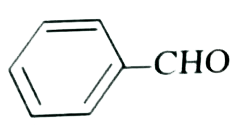Compound 'A' with molecular formula C4H9Br is treated with aq. KOH solution. The rate of this reaction depends upon the concentration of the compound 'A' only. When another optically active isomer 'B' of this compound was treated with aq. KOH solution, the rate of reaction was found to be dependent on concentration of compound and KOH both.
(i) Write down the structural formula of both compounds 'A' and 'B'.
(ii) Out of these two compounds, which one will be converted to the product with inverted configuration.
(i) Compound A=CH3−CH3∣C∣Br−CH3 Compound B=CH3−CH2−C∣BrH−CH3
Tert, alkyl halides react by SN1 mechanism. The rate depends upon the concentration of alkyl halide only. B must be secondary alkyl halide because primary isomer is not optically active. Here SN2 mechanism takes place.
(ii) Compound B, because in SN2 mechanism, inversion of configuration takes place.
Topper's Solved these Questions
- HALOALKANES AND HALOARENES BOOK - U-LIKE SERIESCHAPTER - HALOALKANES AND HALOARENES EXERCISE - LONG ANSWER QUESTIONS -I (3 marks each )
38 Videos
- HALOALKANES AND HALOARENES BOOK - U-LIKE SERIESCHAPTER - HALOALKANES AND HALOARENES EXERCISE - SELF ASSESSMENT TEST ( SECTION A )
7 Videos
- HALOALKANES AND HALOARENES BOOK - U-LIKE SERIESCHAPTER - HALOALKANES AND HALOARENES EXERCISE - VERY SHORT ANSWER QUESTIONS (1 mark each )
44 Videos
- GENERAL PRINCIPLES AND PROCESSES OF ISOLATION OF ELEMENTSBOOK - U-LIKE SERIESCHAPTER - GENERAL PRINCIPLES AND PROCESSES OF ISOLATION OF ELEMENTSEXERCISE - SELF ASSESSMENT TEST
7 Videos
- POLYMERS BOOK - U-LIKE SERIESCHAPTER - POLYMERS EXERCISE - SELF ASSESSMENT TEST ( SECTION -A (ASSERTION AND REASON))
2 Videos
Similar Questions
Compound 'A' with molecular formula C4H9Br is treated with aq. KOH solution. The rate of this reaction depends upon the the concentration of the compounds 'A' only. When another optically active isomer 'B' of this compound was treated with aq. KOH solution, the rate of reaction was found to be dependent on concentration of compound and KOH both.
(i) Write down the structural formula of both compounds 'A' and 'B'.
(ii) Out of these two compounds, which one will be converted to the product with inverted configuration.
View SolutionCompound 'A' with molecular formula C4H9Br is treated with aq. KOH solution. The rate of this reaction depends upon the the concentration of the compounds 'A' only. When another optically active isomer 'B' of this compound was treated with aq. KOH solution, the rate of reaction was found to be dependent on concentration of compound and KOH both.
(i) Write down the structural formula of both compounds 'A' and 'B'.
(ii) Out of these two compounds, which one will be converted to the product with inverted configuration.
View Solution
Knowledge Check
Which product is formed when the compound
 concentrated aqueous KOH solution ? A
concentrated aqueous KOH solution ? A B
B C
C D
D
Which product is formed when the compound
 is treated with concentrated aqueous KOH solution?A
is treated with concentrated aqueous KOH solution?A B
B C
C D
D
Compound 'A' with molecular formula C4H9Br is treated with aq. KOH solution. The rate of this reaction depends upon the concentration of the compound 'A' only. When another optically active isomer 'B' of this compound was treated with aq. KOH solution, the rate of reaction was found to be dependent on concentration of compound and KOH both.
Write down the structural formula of both compounds 'A' and 'B'.
View SolutionCompound 'A' with molecular formula C4H9Br is treated with aq. KOH solution. The rate of this reaction depends upon the concentration of the compound 'A' only. When another optically active isomer 'B' of this compound was treated with aq. KOH solution, the rate of reaction was found to be dependent on concentration of compound and KOH both.
Write down the structural formula of both compounds 'A' and 'B'.
View SolutionCompound 'A' with molecular formula C4H9Br is treated with aq. KOH solution. The rate of this reaction depends upon the the concentration of the compounds 'A' only. When another optically active isomer 'B' of this compound was treated with aq. KOH solution, the rate of reaction was found to be dependent on concentration of compound and KOH both.
(i) Write down the structural formula of both compounds 'A' and 'B'.
(ii) Out of these two compounds, which one will be converted to the product with inverted configuration.
View SolutionCompound 'A' with molecular formula C4H9Br is treated with aq. KOH solution. The rate of this reaction depends upon the the concentration of the compounds 'A' only. When another optically active isomer 'B' of this compound was treated with aq. KOH solution, the rate of reaction was found to be dependent on concentration of compound and KOH both.
(i) Write down the structural formula of both compounds 'A' and 'B'.
(ii) Out of these two compounds, which one will be converted to the product with inverted configuration.
View SolutionCompound 'A' with molecular formula C4H9Br is treated with aq. KOH solution. The rate of this reaction depends upon the concentration of the compound 'A' only. When another optically active isomer 'B' of this compound was treated with aq. KOH solution, the rate of reaction was found to be dependent on concentration of compound and KOH both.
Write down the structural formula of both compounds 'A' and 'B'.
View SolutionCompound 'A' with molecular formula C4H9Br is treated with aq. KOH solution. The rate of this reaction depends upon the the concentration of the compounds 'A' only. When another optically active isomer 'B' of this compound was treated with aq. KOH solution, the rate of reaction was found to be dependent on concentration of compound and KOH both.
(i) Write down the structural formula of both compounds 'A' and 'B'.
(ii) Out of these two compounds, which one will be converted to the product with inverted configuration.
View Solution
